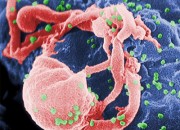Eels and sperms may look similar, but their method of moving is very different, as their Reynolds numbers are far apart. In fact, we can now answer the question, what would it feel like to swim like a sperm or a bacteria? Prepare yourself for a romp through the world of fluid mechanics — with sperm!
Science
The annual Ig Nobel gala happened last night at Harvard and among the winners were some fearless researchers taking a long, hard look at how “beer goggles” affect us. Conventional wisdom goes that the more you drink, the more attractive everyone seems to be. But what about the person drinking? Do beer goggles improve self-assessments of attractiveness? The award-winning findings suggest that not only does alcohol make us feel more attractive, just thinking that we’ve had a drink makes us feel more attractive than we are.
Human clinical trials are starting this month in the United States for SAV001-H, a vaccine developed by a team of researchers at the University of Western Ontario’s Schulich School of Medicine and Dentistry led by Dr. Chil-Yong Kang. The vaccine recently passed the first phase of trials, which were conducted on 40 HIV-positive individuals.
The powerful muscles running across a dolphin’s back and tail stalk (called the “peduncle”) that helps it move its flukes up and down in order to propel itself are the inspiration behind what we know as the “dolphin kick.” This style of movement underwater is so powerful, the governing body of competitive swimming restricts it. Guess what else dolphins do that they might restrict?
This summer sure hasn’t helped clarify the question of monogamy — and I’m not just talking about your escapades, you player, you. In July, two papers digging into the roots of monogamy hit the news simultaneously, one in the Proceedings of the National Academy of Sciences and the other in Science — but instead of bringing the issue closer to rest, the papers offered somewhat contradictory conclusions.
High-schoolers do it. College students do it. Stars do it. Politicians do it. Martha Stewart does it, for God’s sake! No matter how many horror stories we see in the media about people whose partners decided to share their private text messages and images, we’re all pretty much still at it. Last year, a poll by Lookout, a security company, reported that one in every five smartphone users send sexually explicit messages. Why do we persist?
Emory University is trying to understand how people negotiate rules regarding other sexual partners in their relationships.Fill out their survey to help them get a sense of the wide array of relationship agreements that exist in this country. Go on, do it. You overshare all over the internet already, so why not put in your two cents for science?
Hypersexuality, known in popular culture as “sex addiction,” is defined as frequent or increased sexual urges or sexual activity. We’ve seen the phrase thrown around to explain all manner of indiscretions, but is “sex addiction” actually a thing? We asked this question in 2009 and while we still have no answer, we may be getting closer to the truth. Here’s a study from UCLA to get you thinking.
Researchers tackled the question of whether a bigger penis can make a man more attractive to a woman. The answer, it turns out, yes — but only to an extent. According to the study, women give equal importance to height and body shape. Basically, a big penis is an advantage, but not having a big one isn’t the end of the world — so long as a man is tall and has a good shoulder-to-hip ratio. For shorter, unfit men, a bigger penis did little to increase their appeal.
Well, if anyone ever wondered why scientists hate to speak to people in the media, now we know for sure. Yesterday, Bloomberg ran a piece about pubic lice titled “Brazilian Bikini Waxes Make Crab Lice Endangered Species” that might have been brilliant (because: pubes!) except it wasn’t. Not even a little bit. In fact, the authors of the article never get around to corroborating this claim.
















